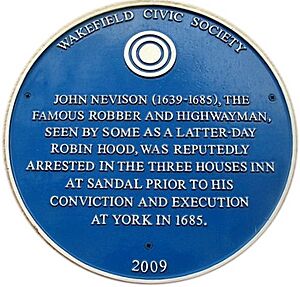John Nevison facts for kids
John Nevison (born 1639 – died 4 May 1684) was a famous English highwayman. People also knew him as William Nevison. King Charles II supposedly gave him the nickname Swift Nick. This happened after Nevison made a very fast ride from Kent to York. He did this to create an alibi for a robbery. An alibi is proof that you were somewhere else when a crime happened. This amazing story later inspired a book called Rookwood. In the book, the author, William Harrison Ainsworth, gave the ride to another highwayman, Dick Turpin.
A Life on the Road
Nevison was born in 1639, likely in Wortley, which is now in South Yorkshire. When he was about 13 or 14, he ran away from home. He might have gone to London. To avoid trouble, he had to go to Holland. There, he joined the Duke of York's army. He even fought in a battle in Dunkirk in 1658.
After leaving the army, he returned to England. He took care of his father for a few years. Then, like many former soldiers, he became a highwayman. Highwaymen were robbers who stopped people on roads. Nevison mostly worked around Newark-on-Trent. He targeted travelers on the Great North Road. This road stretched from Huntingdon in the south to York in the north.
In the mid-1670s, police started investigating his activities. Nevison was known for being a "gentleman highwayman." He was always polite to his victims. He never used violence against them. He only robbed rich people.
The Famous Ride to York
The most famous story about Nevison is his ride from Kent to York. This happened in 1676. Nevison had just robbed someone at Gad's Hill, near Rochester, Kent. To escape, he quickly crossed the River Thames by ferry. Then, he galloped about 200 miles to York. He rode through towns like Chelmsford, Cambridge, and Huntingdon.
He arrived in York at sunset. He made sure to meet the city's Lord Mayor. He even made a bet with the Mayor about a bowls game. Later, when he was arrested for the Gad's Hill robbery, he used this meeting as his alibi. The Lord Mayor confirmed he was in York. Because of this, Nevison was found not guilty.
Capture and End
In 1677, Nevison was caught and found guilty of stealing a horse and highway robbery. He was put in York Castle. He offered to tell the authorities about his partners in crime. Because of this, he was pardoned. A pardon means he was forgiven for his crimes. He was supposed to be sent away from England.
In 1681, he was taken from prison to join soldiers going to Tangier. But he escaped again! A reward of £20 was offered to anyone who could catch him.
Nevison was finally arrested on 6 March 1684. This happened at the Three Houses Inn in Sandal Magna, near Wakefield. He was caught for the murder of Darcy Fletcher. Fletcher was a constable who tried to arrest Nevison earlier. Nevison was taken to York. Because he had broken his pardon, he was told he would die. John Nevison was hanged at Knavesmire on 4 May 1684. He was buried in an unmarked grave in St Mary's Church, Castlegate.
Nevison's Legacy
People really admired Nevison, even after his death. Songs about his adventures became very popular. One famous folk song is called "Bold Nevison the Highwayman." A folk singer named Joseph Taylor knew parts of this song. In 1908, his singing was recorded. You can still hear it today!
Here are some lines from a song about him:
I've now robb'd a gentleman of two-pence,
I've neither done murder, nor killed,
But guilty I've been all my life time,
So gentlemen do as you will
I's when that I rode on the highway,
I've always had money in great store;
And whatever I look from the rich
I freely gave it to the poor.
Nevison's story also appeared in books and music. In 1913, George Edgar wrote a novel called Swift Nick of the York Road. In this story, Nevison is a gentleman who loses his money. He wins duels and eventually gets a pardon from King Charles.
In 1935, Hubert Clifford wrote a music piece for an orchestra. It was called "Swift Nicks of Gad's Hill." This piece also talks about Nevison's famous ride to York. It mentions that King Charles gave him the nickname "Swift Nicks."


